If you’ve ever thought about where, when, or how to go hiking in Korea, then this Korean hiking guide is perfect for you. Whether you’re a novice hiker looking for a gentle stroll through leafy valleys, or a keen hiking enthusiast looking for the next big challenge, these tips will help you avoid common hiking problems and enjoy the peaks more.
A day out hiking is a great way to get some exercise, stretch your legs, and get away from Korea’s concrete jungles. Korea has an abundance of different mountains to choose from, with paths, sights, and breathtaking experiences that are perfect for all levels of hiking ability.
Find out why hiking is one of Korea’s most popular past times, enjoyed by countless people every day, and one of the best way to see stunning views of Korea’s magnificent cherry blossoms, autumn leaves, or even snow-capped mountain tops.
Affiliate Disclaimer: This site contains affiliate links and I may earn commission for purchases made after clicking these links.
What’s In This How To Go Hiking In Korea Guide?
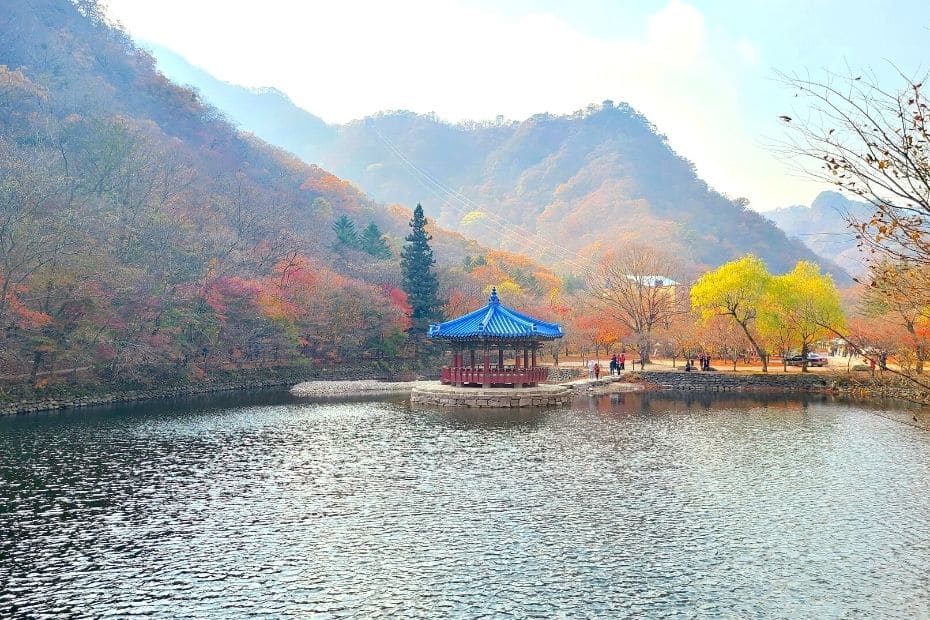
I want to share my 21 top tips to help you go hiking in Korea more easily. This Korean hiking guide includes pre-planning tips, packing tips, tips for dealing with common problems, and how to enjoy the mountains the most. I’ll also share my personal insights to help you hike like a pro.
Later on I’ll cover a bit about the best time to go hiking. I’ll also briefly introduce some of the most popular mountains to hike in Korea and give an overview of the best transportation options for getting to the mountains.
If you’re still not convinced that hiking in Korea is something you should immediately rush out and start trying, there’s a few extra reasons why you should definitely try it at the end. So why should you trust what I say about hiking in Korea?
I’m a self-confessed hiking addict who has hiked extensively across Korea and other countries, including reaching the Annapurna Base Camp in the Himalayas in Nepal. I’ve been to almost every national park in Korea and dozens of other standalone mountains. I also run a hiking group which organises hiking trips to nearby mountains.
Read on and start your Korean hiking adventure as soon as possible!
Planning to visit Korea? These travel essentials will help you plan your trip, get the best deals, and save you time and money before and during your Korean adventure.
Visas & K-ETA: Some travellers to Korea need a Tourist Visa, but most can travel with a Korean Electronic Travel Authorisation (K-ETA). Currently 22 Countries don’t need either one.
How To Stay Connected: Pre-order a Korean Sim Card or a WiFi Router to collect on-arrival at Incheon Airport (desks open 24-hours). Alternatively, download a Korean eSIM for you travels.
Where To Stay: For Seoul, I recommend Myeongdong (convenient), Hongdae (cool culture) or Gangnam (shopping). For Busan, Haeundae (Beach) or Seomyeon (Downtown).
Incheon Airport To Seoul: Take the Airport Express (AREX) to Seoul Station or a Limo Bus across Seoul. Book an Incheon Airport Private Transfer and relax to or from the airport.
Korean Tour Operators: Tour companies that have a big presence in Korea include Klook, Trazy, Viator, and Get Your Guide. These sites offer discounted entry tickets for top attractions.
Seoul City Passes: Visit Seoul’s top attractions for free with a Discover Seoul Pass or Go City Seoul Pass. These passes are great for families and couples visiting Seoul – you can save lots.
How To Get Around: For public transport, grab a T-Money Card. Save money on Korea’s high speed trains with a Korea Rail Pass. To see more of Korea, there are many Rental Car Options.
Travel Money: Use money exchanges near Myeongdong and Hongdae subway stations for the best exchange rates. Order a Wise Card or WOWPASS to pay by card across Korea.
Flights To Korea: I use flight comparison sites such as Expedia and Skyscanner to find the best flights to Korea from any country. Air Asia is a good option for budget flights from Asia.
How To Learn Korean: The language course from 90 Day Korean or Korean Class 101 both have well-structured lessons and lots of useful resources to help you learn Korean.
The Top 21 Hiking In Korea Tips
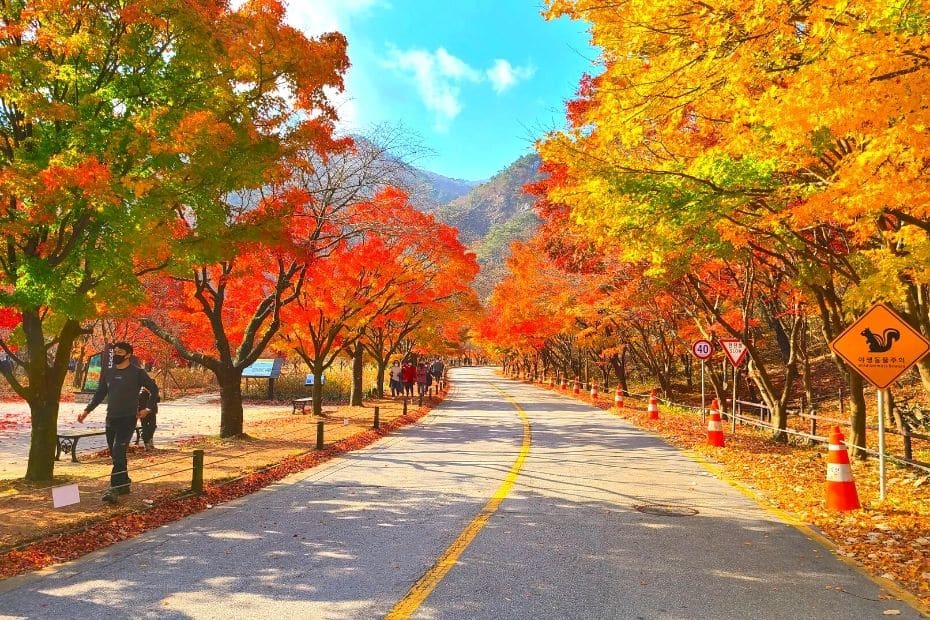
Some of these tips will help you when you’re hiking anywhere in the world, others are specific only to Korea. I’ve broken them down into 4 different categories to help you in the various stages of planning and doing a hike, as well as some tips for when it’s over. These are:
Tips 1 – 5:
Essential packing tips for your hike.
Tips 6 – 10:
Pre-hike tips to avoid problems.
Tips 11 – 17:
Tips for when you’re hiking.
Tips 18 – 21:
Post-hike and accommodation tips
Now, without further ado, here are my top 21 tips for an incredible time hiking in Korea:
1: Pack Light – It’ll Make Hiking Easier

There’s nothing worse when you’re hiking than getting tired from hauling around a heavy backpack full of stuff you’re not using. You’ll feel every kilo as you go up the steep steps! Carrying extra goods that you won’t need is going to leave you sweating. Reduce what goes into your backpack as much as possible and leave all non-essentials at home.
I have a separate hiking backpack just for hiking. It’s been stripped of all the everyday stuff we might stick into our bags normally and I only add what I need for a day hike.Buying a decent backpack / day bag will cut out weight as well. A good bag is a worthwhile investment if you want to go hiking in Korea regularly.
Tip: Try to get a good quality hiking backpack that includes side pockets for water bottles and enough space for snacks and other goods. Bags with proper support, waist and chest straps, and a waterproof cover are even better.
I would recommend something like this: Waterproof Hiking Backpack
2: Pack Right – Essential Items For Hiking
Even though you’ll want a light backpack when you hike, there are some essential items that you’ll want to bring whenever you hike.
Besides food and water (I’ll cover them next), here are some essential items that I always bring when I go hiking:
- Tissues – they have many uses and you’ll need them.
- Wet wipes or hand sanitiser – if you want to clean your hands before eating.
- Sweat towel – especially if you’re hiking any time between spring and autumn.
- Hiking sticks – good for tackling stony paths and in wet weather.
- Plastic bag – there are no bins on the mountains, this is for taking rubbish home.
- Emergency snacks – in case you didn’t bring enough food. I usually pack a spare Calorie Balance.
- Insect repellant (summer) – if you’re hiking in summer, you’ll need it.
- Cash – it’s always good to have some money in case you need it.
There are a few other things you’ll want to bring, but I’ll cover those in more details in the next few tips.
Tip: Cash is useful for buying snacks and drinks on the way. There are often small stalls with goods.
3: Bring Food & Water For The Journey
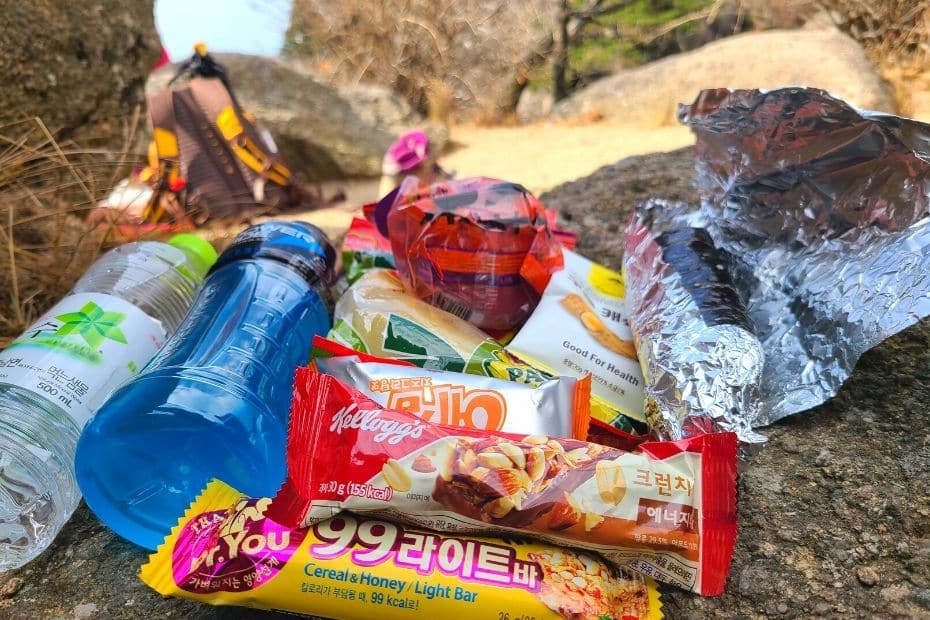
If you’re planning a whole day of hiking, then you’ll want to pack the right food and liquids to keep you going. Staying hydrated is one of the biggest issues when hiking, especially if you’re hiking during the summer.
I generally bring 1 litre of water for a day hike in winter (you don’t sweat as much) and 2 litres for summer. You can switch out a bottle of water for an energy drink like Powerade or Gatorade. Coke and other fizzy drinks won’t help you – leave them at home.
For food and snacks, I usually pack a mixture of:
- Fruit – Bananas, apples, oranges, persimmon, etc.
- Veg – Tomatoes, carrots, dried sweet potato, etc.
- Nuts – small bag per person.
- Cereal bar – for when you need something sweet.
- Gimbap – perfect for lunch and sold in most national parks. Avoid seafood/mayo.
- Sandwich – same with gimbap, good for lunch mid-hike.
- Crisps / Choc – sometimes you need something yummy.
The picture above is an example of what I usually bring on a hike. There are restaurants in the starting areas in national parks where you can fill up after a hike. Remember, try to pack light and avoid over-packing with food.
Tip: If you want to become a true Korean hiker, bring a bottle of soju to drink at the top. Share it with others that you meet so you don’t get drunk and roll down the mountain though!
4: Don’t Forget About Sun Protection!
This is so important that it deserves its own section. When hiking in Korea’s many high, open mountains, it’s quite easy to get exposed to a lot of sunshine and get burnt without noticing it.
As someone with no natural defence from the sun on the top of my head, I can speak with great experience about how important it is to protect yourself from the sun.
Remember to always bring:
- Sunglasses – this is even more important if you’re hiking in winter with snow on the mountains.
- Sun cream – slap it on before you hike and after you eat lunch.
- Sun hat – not essential, but will help keep out the sun and also protect from mosquitoes.
I usually apply sun cream before hiking and also when I’m at the peak, which is where you’ll be the most exposed. Even if it’s not that sunny, it’s still good to be protected from the sun.
5: Dress Appropriately For The Hike

The first thing you’ll notice when hiking in Korea is the vast array of bright, almost luminous clothing the locals are bedecked in. Fortunately, this isn’t essential to have a good time hiking. However, wearing the right kind of clothes in each season is going to make hiking a lot more comfortable.
Here’s what I’d recommend for each season:
Spring & Autumn:
Top: Light top. Jacket you can store in your bag.
Legs: Light trousers to protect from insects.
Feet: Regular hiking socks.
Summer:
Top: Long-sleeved thin hiking or cotton t-shirt.
Legs: Long shorts or trousers to protect against mosquitoes.
Feet: Ankle socks.
Winter:
Top: Layers that you can remove easily. Jacket with wind protection, thin fleece.
Legs: Thick or lined trousers (with leggings if really cold).
Feet: Woollen hiking socks.
Tip: A decent pair of hiking boots is the best investment you can make when hiking. I use the same pair all year round and they keep my feet and ankles safe and protected from injury. They also help me in bad weather conditions.
These are the hiking boots I use North Face Men’s Gore-Tex Hiking Shoes
6: Plan Your Route Before You Leave
Korea has a vast network of hiking trails that criss-cross national parks and standalone mountains across the country. Choosing the right route for you should be the first step when planning to hike.
Do you want to hike for a half day or full day? Do you plan to stay overnight somewhere and continue hiking the next day? Do you want to start and finish in the same or different place? Knowing the answers to these questions before you leave helps to avoid problems later on.
Tip: There are loads of routes listed on the KNPS Website for each national park in Korea. You can easily find one that suits your ability, time, and plans.
7: Check For Trail Closures
There’s nothing worse than planning a day’s hike and turning up early in the morning to find the route is closed. It’s happened to me before and it sucks. If you’re lucky, there are alternative routes nearby that are open, but sometimes there aren’t.
Trail closures are most common during autumn and winter, when there is a higher risk of fires from the dry weather and fallen autumn leaves. There could also be closures when there’s been a flood or some repair work is going on.
Fortunately, there are usually notifications about when trails will be closed in advance. You can check these on the Korean National Park Services Notice Section.
8: Watch Out For Bad Weather
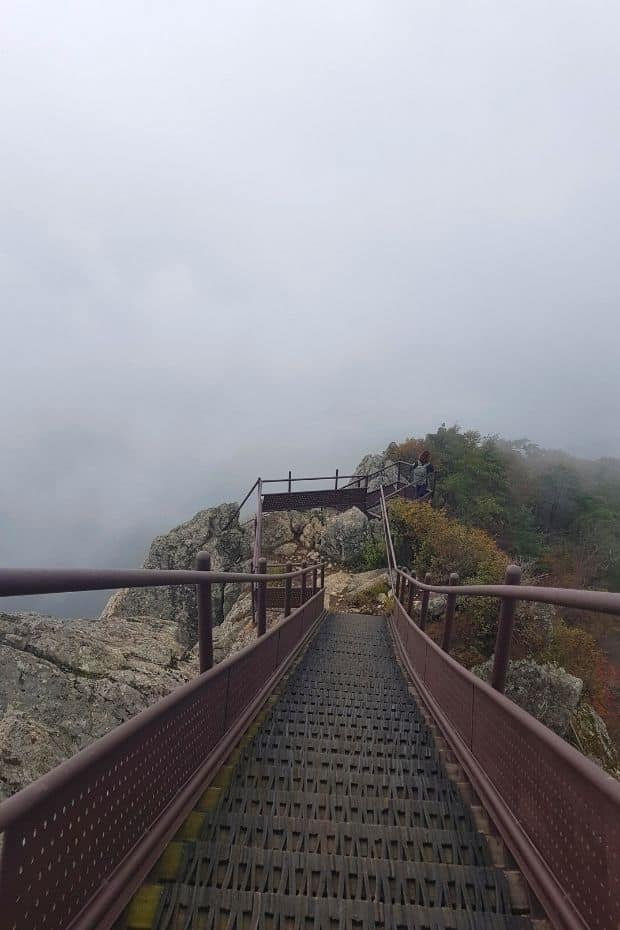
There’s nothing worse than scaling a 1,500 metre mountain only to end up with views like the one above – clouds and fog blocking your hard-earned view. Unfortunately, that’s one of the risks you take when hiking in Korea.
Whilst there’s not much you can do to control the weather, you can certainly prepare for it and make sure to hike responsibly when it appears. Check weather forecasts during the week before you plan to hike, as well as before you set off.
If there’s any chance of rain, pack an umbrella and waterproof jacket. If it looks like a blizzard (winter) or typhoon (summer) is going to hit, you should probably postpone the hike.
Fortunately, Korea has a lot more sunny days than bad weather days. I don’t know if I can say the same about where I grew up (England).
9: Keep An Eye On Air Pollution
Another thing you have to watch out for at certain times of the year in Korea is air pollution. This is referred to as ‘fine dust’ in Korea and comes from air pollution generated in Korea and neighbouring countries, as well as yellow dust blown in from deserts in China and Mongolia. Fine dust is generally highest in winter and spring, and not so bad in summer and autumn.
Hiking in fine dust can be a health risk for some people sensitive to air pollution, who might not feel too comfortable when breathing heavily. Fine dust also ruins the view and creates a yellow haze that looks like fog. I recommend checking the fine dust levels (most weather apps include it these days) and if the levels are over 200, postpone the hike for another day.
10: Know How To Get Home
This is a really important thing to consider when you’re hiking, especially if you’re hiking in a remote area with nowhere to stay and relying on public transportation. The last bus from national parks usually leave after the sun has gone down (you can’t hike at night). This is around 6 or 7pm.
When you’re hiking, make sure you have enough time to get back to the bus stop to get home. Also make sure you know when the buses run and where they will leave from.
You can plan routes and check buses through apps like Naver Maps and Kakao Maps. They should show you which buses go to the mountains and when they run.
Tip: If you plan to leave from the same bus stop that you arrived at, take a photo of the departing bus times before you start hiking.
11: Start Early To Avoid The Crowds
The early bird not only catches the worm, they also get to enjoy incredible views before everyone else starts crowding the peak and blocking up the paths.
The weekends are very popular for hiking in Korea and many people will drive to the national parks for a day in nature, enjoying the glorious views and peace that comes from hiking. If you don’t want to be caught up with the crowd, then get out early and avoid the tour buses crammed full of happy hikers.
Not only will it be less busy, it’ll also be cooler (very important in summer), you can reach the peak more quickly, and you’ll have more time to explore other routes or head back down for an early dinner.
And you won’t miss that last bus!
Tip: Get up early, grab a coffee, sleep on the bus, hike before the others. I usually get up around 5:30 – 6:00am during autumn for early morning hikes. Later in winter as the sun rises later on.
12: Take A Picture Of The Hiking Route
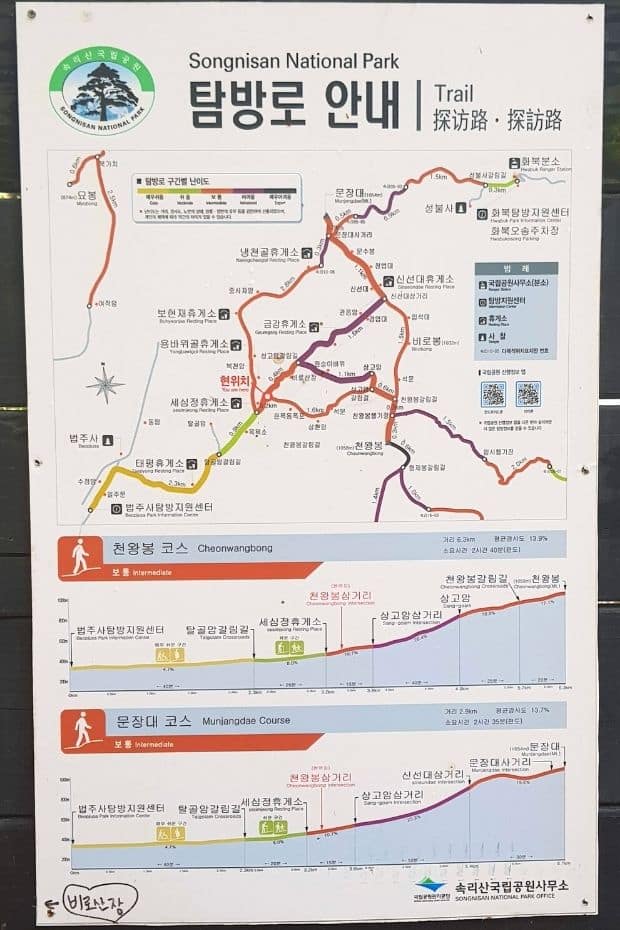
As you can see from the picture above, Korean hiking guides are written in both Korean and English (as are most signposts). These signs are great and help you plan your course, work out the optimal route for you, and show you the expected time and distance for each section. You can find these Korean hiking guides at the start of the course and at major junctions along the way.
Unfortunately, they aren’t at every junction and if you aren’t sure which way you’re meant to go, you might end up taking the wrong route. If you have a picture of the map, you can generally figure out where to go though.
Work out which peak you want to head to and follow the signposts for that peak. On the way back, follow the signposts to the starting point.
Tip: The advanced (purple) and expert (black) routes aren’t impossible for novice hikers. They usually mean that these sections are steep or more difficult to hike through. They are usually at the top of the mountain and might involve steep staircases or difficult terrain.
13: Make The Most Of Early Toilets
No guide to hiking in Korea would be complete without discussing this delicate issue – when and where to go to the toilet. Whilst it may be ok for the bears, you’ll probably want to make the most of good toilets while you can.
Korea’s mountains are probably some of the most organised and well equipped that I’ve ever had the pleasure of hiking. The starting areas usually have very modern, even heated, toilets with an ample supply of toilet paper. However, the further up the mountain you go, you really shouldn’t expect such luxuries.
Whilst some mountains may have good services, especially those with Buddhist temples along the route, other ones have rather…crappy toilets. If you’re at the peak, there won’t be any at all.
Do your business before you hike. Not only will it avoid problems later, you’ll also feel fresh and ready for anything! Find out more about using public toilets while hiking with my guide to Korean public toilets. It’s packed with lots of useful information for doing your business in Korea.
Tip: Don’t forget to pack some toilet paper or wet wipes.
14: Take Breaks & Stretch A Lot
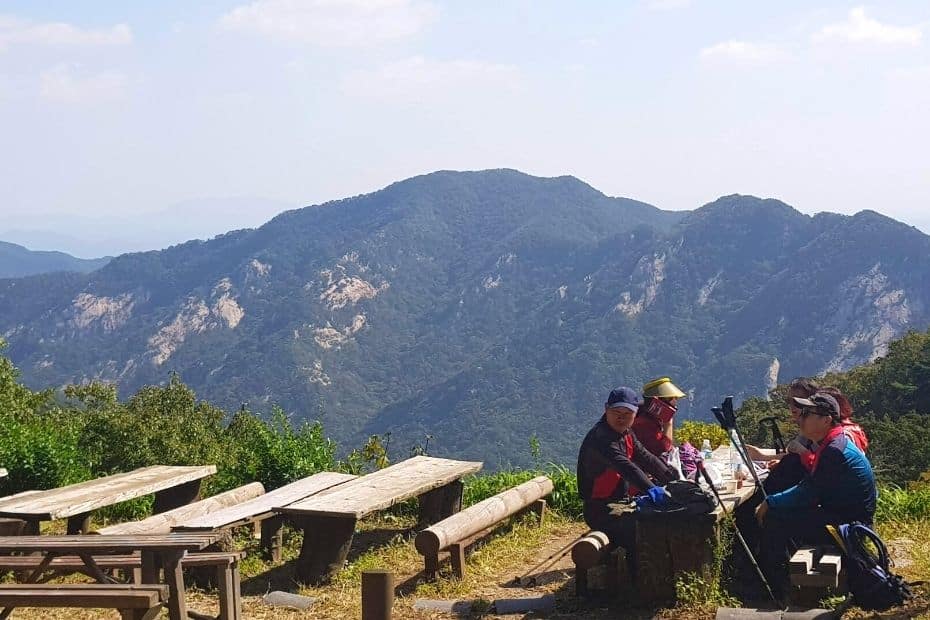
A common complaint of novice hikers is the amount of pain and stiffness they feel after a day of hiking. Whilst this is normal when you do something you don’t normally do, it can be mostly avoided by looking after your body when you hike.
Take regular breaks and go at a pace that you’re comfortable with. There are plenty of benches, pagodas, and other rest spots (as pictured) where you can sit down and give your legs a break.
Stretching before and after the hike is great for avoiding pulled or tired muscles. Try to do a range of stretches for your legs, back, and shoulders. Your whole body will get a workout from hiking. I like to stretch a bit when I’m at the peak or whenever I stop for longer than 10 minutes. A few minutes of stretches will save you a lot of pain.
Tip: Hold stretches for 20 seconds before you hike and over 30 seconds after the hike.
15: Follow The Signs & Stick To The Path
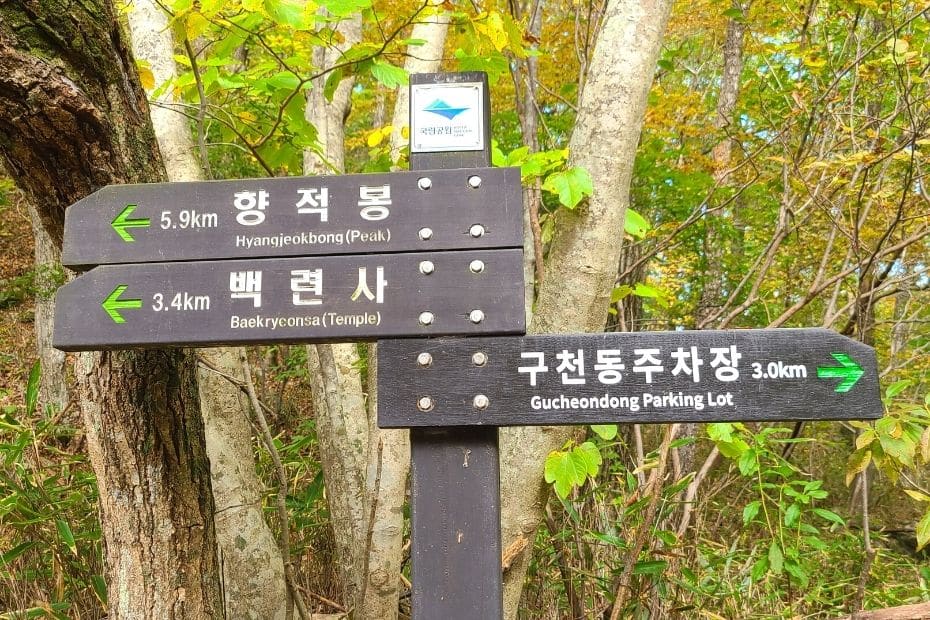
Hiking in Korea is very organised and well planned out, which makes it very easy to get around the mountains safely and to plan your hiking adventures. Unfortunately, this also means the trails are very controlled and you’re not allowed to hike off-trail. This makes sense when you know that there are bears, wild boars, snakes and other animals hiding in the wilds!
The hiking trails are really well laid out and will tell you exactly where to go and how long it’ll take. I’d recommend following them and not trying to find your own way. There are reports of people getting lost in the mountains and never being found again – don’t be one of those people.
Some areas are also reserved for the military or have other, unknown dangers (landslides, rockfalls etc.). If you follow the Korean hiking guide signs, you’ll be fine.
16: Take Your Trash Home With You
When you enter one of Korea’s many national parks, you’ll see the motto “our nature, our future”.
Koreans have a respect for nature and the health of their mountains and national parks, with some being holy spots and featuring important Buddhist temples. As such, they know not to ruin the landscape with unwanted wrappers, food waste, cans, bottles, and other garbage.
Please be a responsible hiker when enjoying the wondrous mountain scenes and take your trash home with you. Thanks.
Tip: You usually get a plastic bag when you buy snacks or lunch items. Keep it to carry your trash home.
17: Be Respectful At The Buddhist Temples
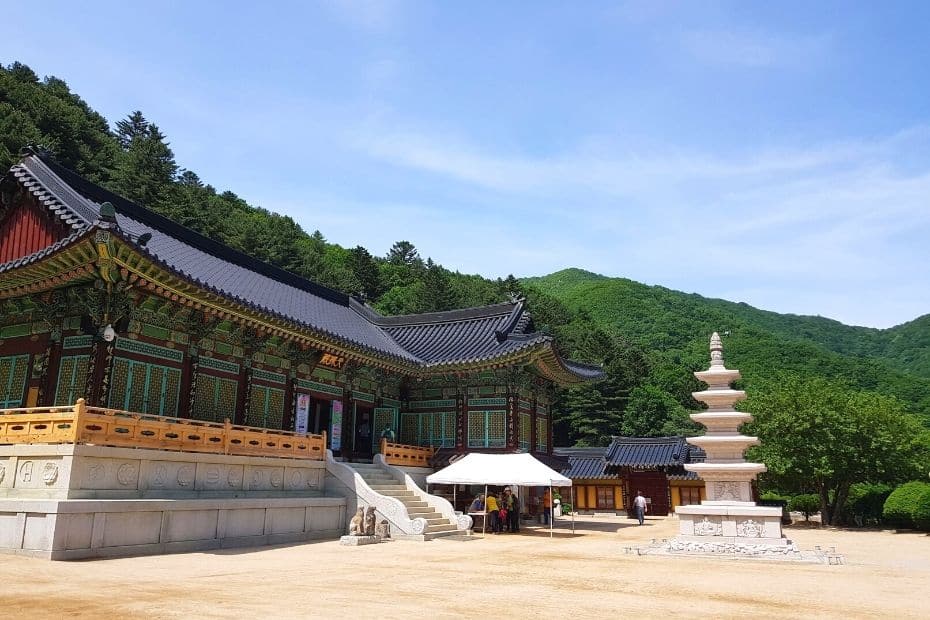
Not only should you respect nature when you’re out hiking by taking your trash home, it’s best to mindful of etiquette and cultural rules when you visit Korean Buddhist temples. You’ll find Buddhist temples at the entrances or inside almost all national parks, and it would be remiss not to mention them in any Korean hiking guide.
A few essential rules you should follow include:
- only enter the temple buildings if signs say you can.
- take your shoes off when entering a temple building.
- try to avoid taking pictures inside temple buildings.
- ask the Buddhist monks before taking their picture.
- be quiet inside the temple grounds
The rules aren’t as strict as you might find in a Thai temple, for example, where you’re expected to cover bare arms and legs. Knowing some common Korean etiquette rules will go a long way to connecting with Korean culture and understanding unspoken rules of behaviour when in Korea.
18: Stay Overnight At A Pension
Want to make a weekend of it in the mountains and go hiking on both days? Then why not stay overnight at one of the many pensions (guesthouse) that surround the entrances to national parks and popular mountains?
These are cosy places that range from a bedroom to full apartments with views over the majestic mountains and often include BBQ facilities for those who want to cook their own dinner. I love staying in these places, You get the chance to have two full days of hiking (with a big Korean BBQ after the first day) and you don’t have to worry so much about getting the bus home on the first day.
You can find pensions on hotel booking sites such as Hotels.com, Booking.com, and Agoda.com. There are also campsites where you can pitch a tent or rent a caravan for the night. Great in summer, but probably best avoided during winter when it gets really cold!
Please note: Some national parks have campsites. These are great places to stay for that authentic outdoors experience. However, camping outside of the campsites is generally illegal.
19: Book A Lodge For Sunrise Hikes
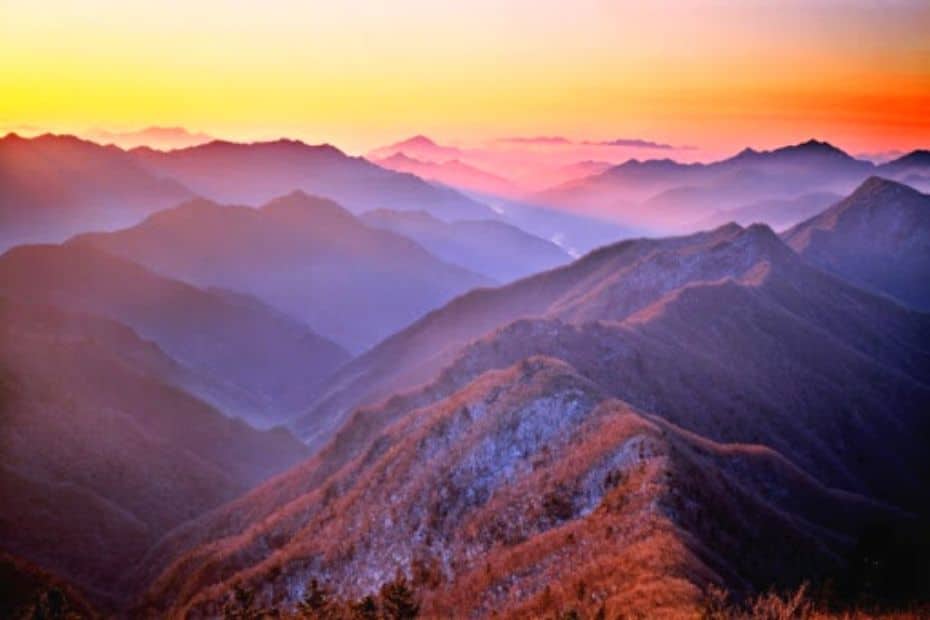
One of the best hiking experiences you can find in Korea is waking up near the top of the tallest mountains and setting off to watch the sunrise from the peak. See the sun rising up from the east, illuminating the peaks and spreading light to the valleys and lands below. It’s a truly breathtaking sight.
At the following national parks you can rent a shelter or cabin high up in the mountains to do just that:
- Seoraksan National Park
- Jirisan National Park
- Deogyusan National Park
The simple shelters provide somewhere to sleep and prepare meals (most people eat ramyeon). They are heated, but you’ll need to bring your own cooking supplies and bedding. Some food might be available in the shelters, depending on which one you go to. If you want to book a shelter to see the sunrise, you’ll need to book 15 days in advance. Find out how to book an overnight shelter.
Tip: Everyone is crowded into two large rooms (split by gender) and it can be noisy. Bring ear plugs to block out the noise of others sleeping.
20: Buy A Souvenir Towel
Did you know that every national park in Korea has its own unique souvenir towel with a map of the hiking routes on it? These are great collectable items that come in a range of bright colours and are very useful in different situations.
They work well as a backup map, a sweat towel, something to wrap up your snacks in, and more. You can find these towels at the gift shops and stores at the entrances to national parks. They’re usually hanging up outside the shop.
Tip: There are 17 national parks in Korea. Why not try to collect a towel from each one?
21: Finish With Amazing Korean Dishes

The last tip on my Korean hiking guide is the one I always follow at the end of a long hike – resting and recharging with a delicious meal at one of the restaurants in the national parks.
You’ll find incredible food, often with locally-sourced ingredients and regional specials. The most popular food after hiking is pajeon (Korean pancake, pictured above) or Korean BBQ. Other popular dishes include bibimbap (mixed rice with veg), acorn jelly salad, and tofu stew.
Of course, you should wash it down with a bowl of creamy makgeolli (rice wine), beer, or soju. After a hard day of hiking, you deserve to put your feet up and enjoy something delicious!
Eating pajeon and drinking makgeolli after an enjoyable hike is so good, I’ve included it as one of my top Unique Korean Experiences that you must try when you visit Korea.
Tip: If you want to drink makgeolli, try to find out what the local variety is. It’s a great way to experience flavours you wouldn’t normally find in other parts of Korea. If you’re near Daejeon, try the local chestnut makgeolli – it’s my favourite!
Why Should I Go Hiking In Korea?
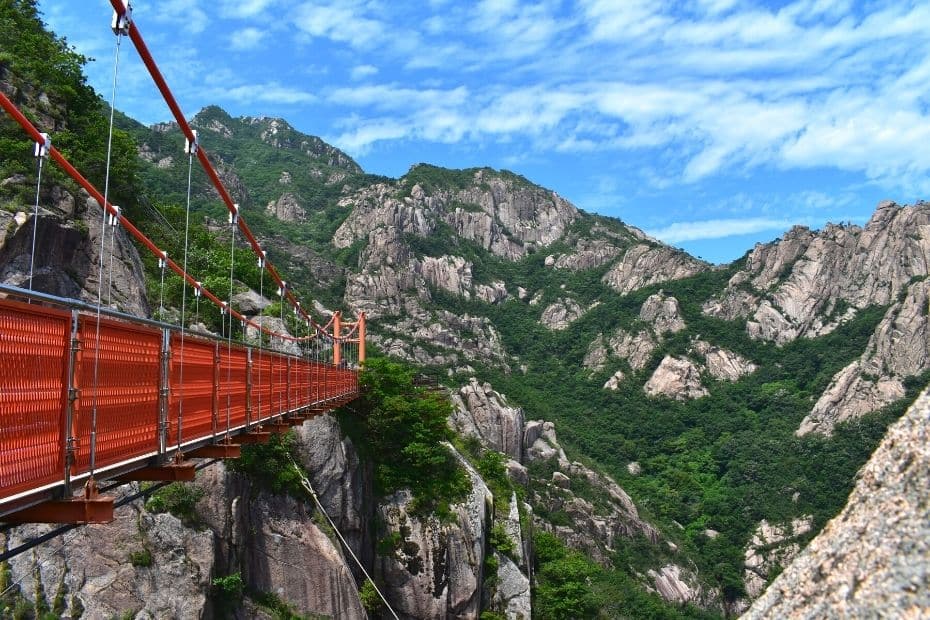
I hope this guide to hiking in Korea has inspired you to get your boots on and go out and experience the incredible scenes you can find all across Korea. In case you’re not convinced about why hiking is a must-do activity in Korea, here are a few more reasons why you should try it:
- It’s great exercise – A day hiking in the mountains can burn hundreds or even thousands of calories and work many different muscles.
- To make friends – There are many social clubs where people go hiking together. It’s a great way to meet new people and find people who like to get out and enjoy nature.
- You’ll see incredible sights – There are incredible scenes waiting to be discovered out there. Waterfalls, friendly squirrels, forested valleys, frozen lakes, snowy peaks, autumn leaves, cherry blossoms, and so much more.
- It’s a cheap day out – Unlike a day at a theme park or visiting expensive attractions, hiking is really cheap. Park entrance fees are a few thousand won and food and snacks don’t cost much at all.
- Chance to see snow – if you’re looking for snowy sights, the mountains during winter are the best places to find them.
- The best Buddhist temples – whilst Seoul has some nice temples, the best ones are all hiding in the national parks. You can even do a temple stay and enjoy hiking in the mountains at the same time
For those living in Korea, I’d recommend joining a hiking Facebook group such as the Seoul Nature & Hiking Group or Hiking In Korea. For those near Daejeon, there’s also the Daejeon Hiking Group (which I manage).
Did you know that one translation of ‘Korea’ is ‘land of high mountains and sparkling streams‘? Whenever you go into the Korean countryside, you’re surrounded by mountains and awe-inspiring views. You’ll easily understand why it has that name.
Wherever you go hiking in Korea, don’t forget to take some photos. You’ll see stunning views, sweeping vistas, and incredible foliage. Check out this article for some interesting hiking captions and quotes for instagram to share the perfect story.
Seasonal Korean Hiking Guide

The best seasons for hiking in Korea are definitely spring and autumn, which both feature warm, sunny days and clears skies while you hike. Summer and winter are tougher, but also have their own rewards. You can see many wonderful and unique sights in each season and they all offer very different views and hiking experiences.
I’ve written a really useful article all about hiking in Korea in different seasons, It’s packed full of useful tips to help about what to expect in each of Korea’s unique season, including my personal recommendations about the best mountains to hike at different times of the year, what to bring, and what you can see.
Finally, if you want some general tips for hiking anywhere in the world, be sure to check out these 17 hiking tips for beginners and for travellers to Ireland, here’s some tips for backpacking Ireland.
The Best Places To Go Hiking In Korea
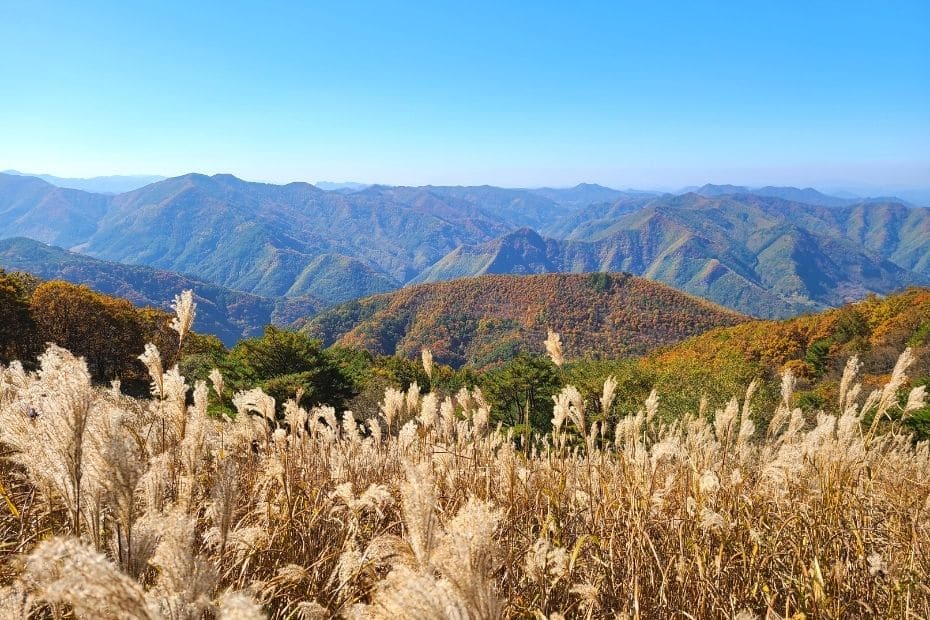
There are literally hundreds, if not thousands, of mountains to choose from if you want to go hiking in Korea. The country is 70% mountainous and knowing which ones are the best ones you should visit can feel a bit overwhelming.
The list below are for the best mountains you can visit from Seoul and then the best mountains you can visit across Korea in case you’re starting from other locations.
Best Mountains To Hike In Seoul:
These mountains are all inside Seoul and accessible by public transport
- Bukhansan National Park
- Namsan Mountain (N Seoul Tower)
- Inwangsan Mountain
- Gwanaksan Mountain
- Cheonggyesan Mountain
- Ansan Mountain
- Achasan Mountain
Find out more about the Best Mountains To Hike In Seoul from Seoulinspired. If you want to hike in Seoul, check out my guide about how to hike in Bukhansan National Park.
Best Mountains To Hike In Korea:
For other parts of Korea, here are some of the best national parks that are typically suitable for all levels.
- Seoraksan National Park
- Odaesan National Park
- Jirisan National Park
- Hallasan National Park (Jeju)
- Gyeryongsan National Park
- Songnisan National Park
- Naejangsan National Park
Find out more about the best mountains to hike in Korea and a detailed guide about how to get to Naejangsan National Park and why you should hike there this autumn.
How To Get To The Mountains In Korea
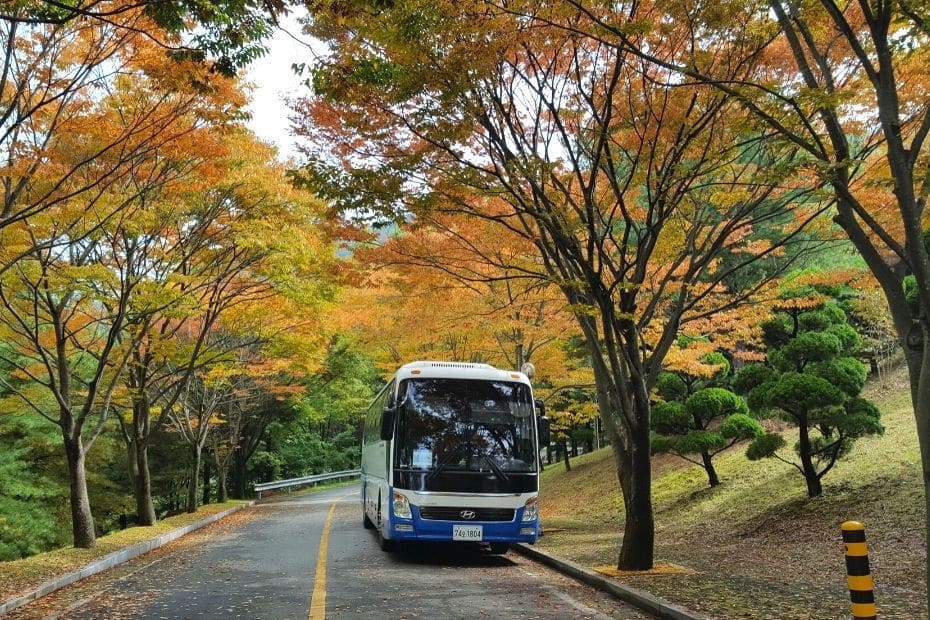
Here are a few tips about how to get to the mountains to start your hiking journey.
By Car
If you have car, then you won’t have many problems getting to the mountains. Look for the national park entrances, there are usually car parks right outside. Be careful during the busiest times (cherry blossom & autumn leaves season) as traffic can be backed up. Arrive early and leave early to avoid the worst traffic.
By Public Transport
Korea has an amazing bus and train network that goes to the most remote national parks. I don’t own a car and have had to rely on public transport to get to most places. You’ll need to do some research, and check the routes with Naver / Kakao map apps, as well as Korean bus apps, but it’s certainly possible.
A lot of the major hiking destinations have online guides and you can find out the best way to get there with a quick search. It’s often cheap but be prepared for long journeys. That’s not so bad as you can sleep on the way.
By Taxi
If you travel to nearby towns, getting a taxi is a reasonably priced and convenient option to get to the hiking routes.
For example, if you want to hike Daedunsan near Daejeon or Odaesan near Jinbu, you can get a taxi from these places and be there in 20 – 30 minutes. It’s a lot more convenient as the buses aren’t that frequent.
By Tour Operator
There are a number of great tour operators that provide tours for locals living in Korea or tourists visiting Korea. These can be more expensive than taking public transport, but also get your straight to where you want to go without detours and long waits between connections.
Furthermore, tour operators also provide insights from local guides, extra stops along the way with additional activities you might never get the chance to experience, as well as visiting several famous locations in the same area.
Recommended Online Tour Operators
Facebook-Based Tour Companies
There’s also the option to hire a private driver to take you to various places and guide you around.
Frequently Asked Questions
Here are some frequently asked questions about hiking in Korea. These answers are based on my own experience and from research conducted to write this article. If you have any more questions about this topic, please feel free to post a comment at the end of this article.
Is Hiking In Korea Suitable For Families?
Yes. There are many family friendly places to go hiking in Korea and you’ll often see children as young as 4 or 5 hiking, even all the way to the peaks. There are a number of ‘recreational forests’ in Korea which are designated as family-friendly areas for gentle hiking and trekking. Most national parks feature flat walking areas.
What’s The Best Place To Hike Near To Seoul?
Bukhansan National Park. Seoul, like most other places in Korea, is surrounded by several large mountains. The best of these for hiking is Bukhansan National Park, which is actually within the city itself and can be accessed by bus or subway. There are various hiking routes in the park, as well as several Buddhist temples to see along the way.
What’s The Best Place To Hike Near Busan?
Jirisan National Park. Although not in Busan itself, Jirisan National Park, Korea’s largest national park, is only a short drive or ride away from Busan and provides the highest peak on mainland South Korea. There are over a dozen trekking courses around the park, as well as incredible sights of Korea’s famous cherry blossoms and autumn leaves. Alternatively, the southern parts of Geoje provide good hiking, including Hallyeohaesang National Park.
Can I See Snow When Hiking In Korea?
Yes, during winter. Whilst snow isn’t guaranteed, you’re likely to see it while hiking in Korea during winter (December to February). The chance of seeing snow increases in the northern part of Korea, which is where you’ll find many high mountains and ski resorts. Mountains such as Seoraksan and Taebaeksan are popular winter hiking spots for people who want to see snow in Korea. You can also see snow as far south as Hallasan Mountain on Jeju Island during some parts of winter.
Do I Need Special Equipment To Hike In Korea?
No. For most mountains in Korea you won’t need any special hiking equipment, just a set of good boots and appropriate clothing. However, if you plan to hike during winter in Korea, hike overnight, or on one of the harder mountains (Seoraksan, Chiaksan, Hallasan), I would recommend preparing special equipment. In winter it’s best to have heat packs, crampons (spikes), heat-warming clothing, removable layers, and hiking poles. If you’re going to hike overnight, be sure to pack a sleeping bag and enough provisions for the entire trip.
Will I Get Altitude Sickness While Hiking In Korea?
No. You won’t get altitude sickness while hiking in Korea. Korea’s tallest mountain is Hallasan, which is around 2,000 metres above sea level. Altitude sickness doesn’t start until you reach 3,000 metres above sea level.
When Is The Best Time To Go Hiking In Korea?
Spring and autumn. Although you can go hiking any time in Korea, the best times (and busiest) are definitely in spring and autumn. The weather is warm and sunny, there are fewer insects than you’d find in summer, and there are a lot of incredible natural sights to see, such as cherry blossoms (April) and autumn leaves (October). Summer is a difficult time to hike, but you can still enjoy walking in the cool, shaded valleys. Winter is cold but offers rare sights of snow.
Liked This? Pin It For Others
If you enjoyed reading this article, then please share this with your friends on Pinterest.
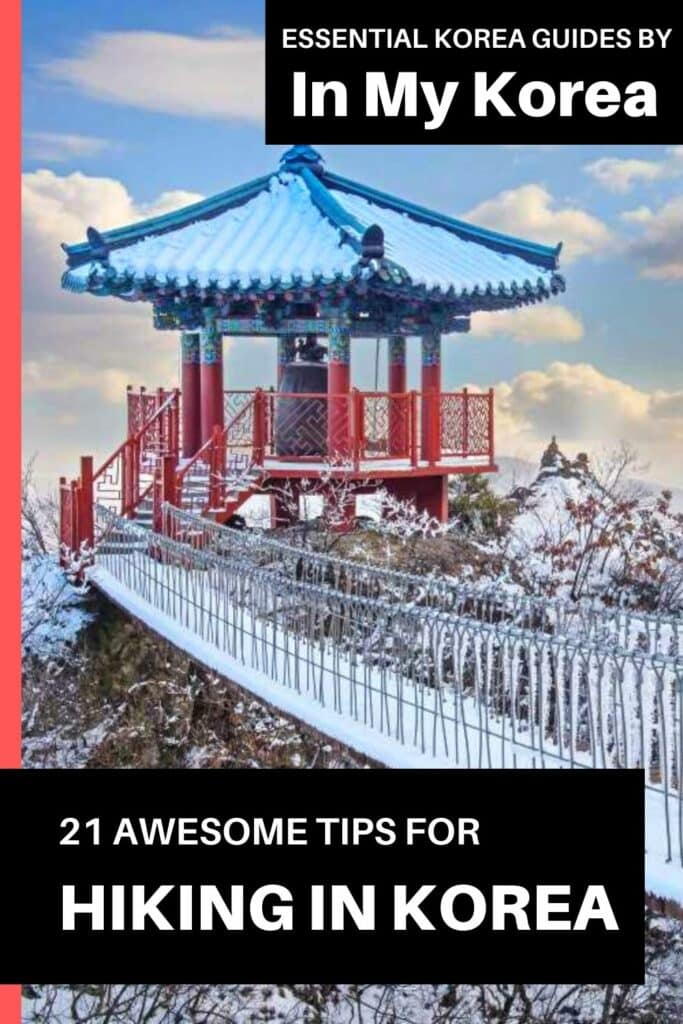
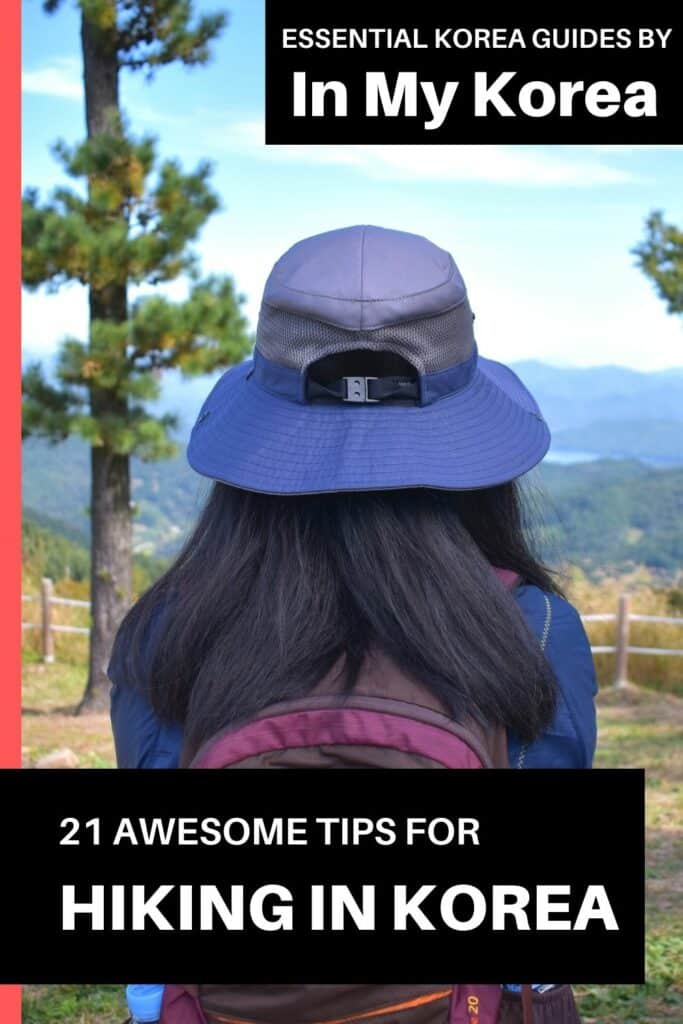
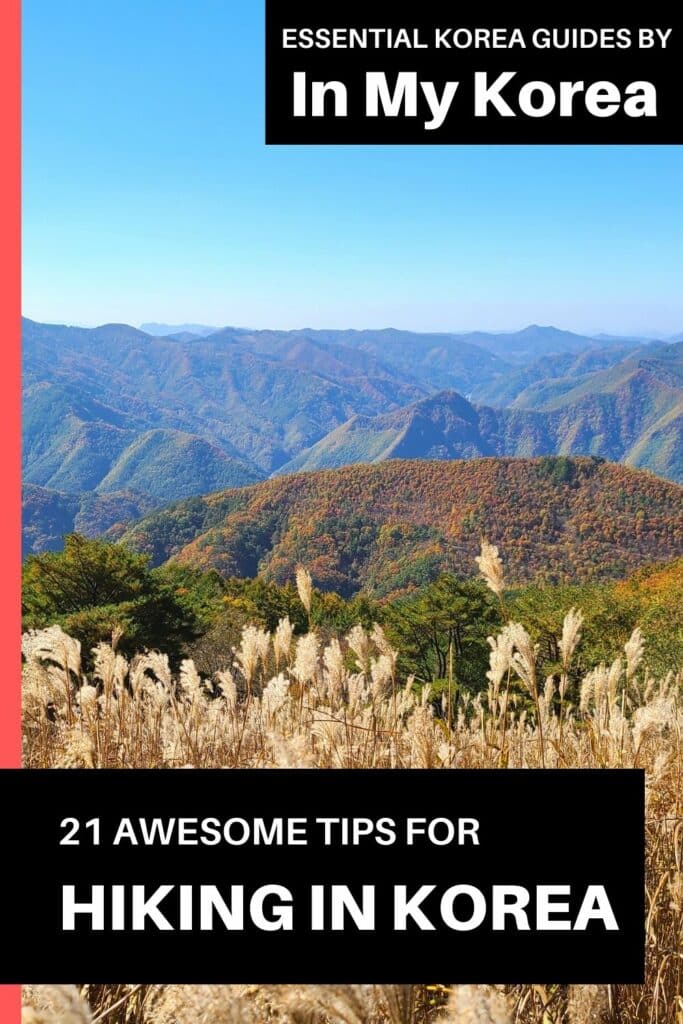


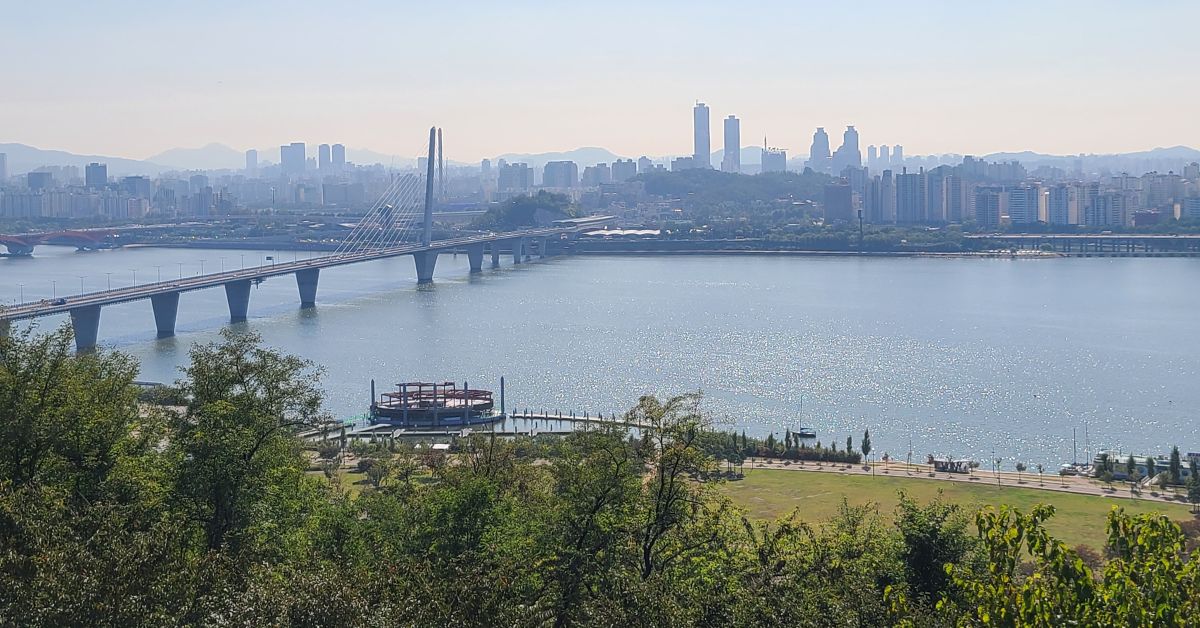

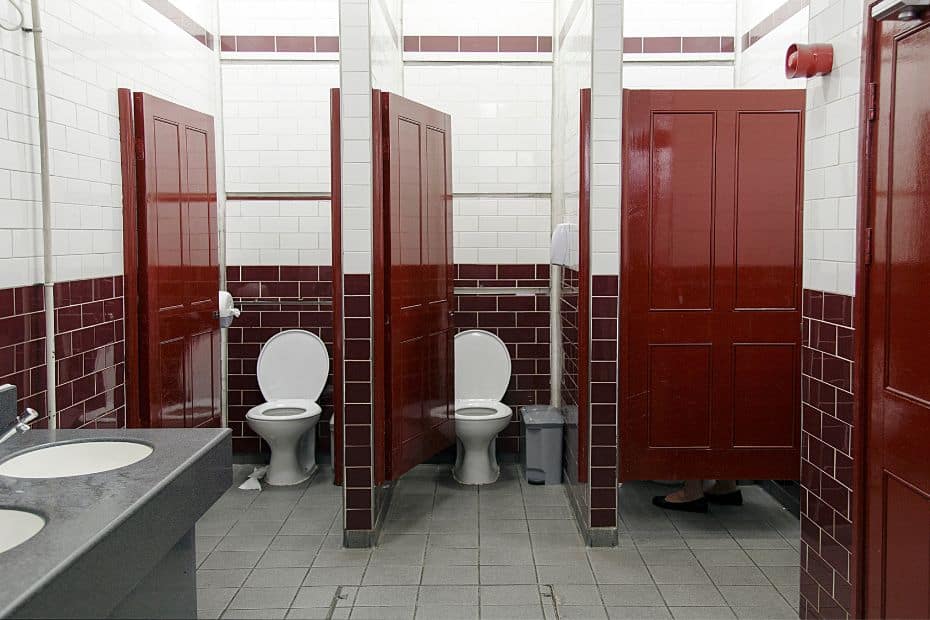

Thanks for the marvelous posting! I truly enjoyed reading it, you can be a great author.I will ensure that I bookmark your blog and will often come back down the read.